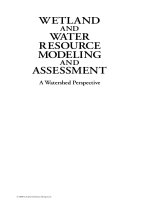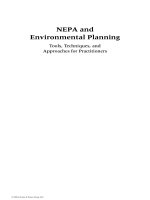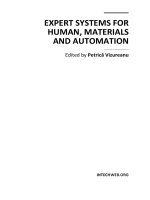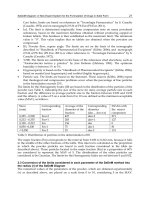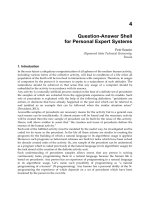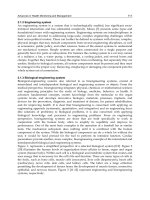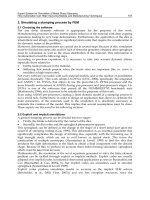Expert Systems and Geographical Information Systems for Impact Assessment - Chapter 1 ppt
Bạn đang xem bản rút gọn của tài liệu. Xem và tải ngay bản đầy đủ của tài liệu tại đây (816.84 KB, 31 trang )
Expert Systems and Geographical
Information Systems for Impact
Assessment
© 2004 Agustin Rodriguez-Bachiller with John Glasson
Expert Systems and
Geographical Information
Systems for Impact
Assessment
Agustin Rodriguez-Bachiller
with John Glasson
Oxford Brookes University, UK
© 2004 Agustin Rodriguez-Bachiller with John Glasson
First published 2004
by Taylor & Francis
11 New Fetter Lane, London EC4P 4EE
Simultaneously published in the USA and Canada
by Taylor & Francis Inc,
29 West 35th Street, New York, NY 10001
Taylor & Francis is an imprint of the Taylor & Francis Group
© 2004 Agustin Rodriguez-Bachiller with John Glasson
Typeset in Sabon by
Integra Software Services Pvt. Ltd, Pondicherry, India
Printed and bound in Great Britain by
MPG Books Ltd, Bodmin, Cornwall
All rights reserved. No part of this book may be reprinted or
reproduced or utilised in any form or by any electronic,
mechanical, or other means, now known or hereafter
invented, including photocopying and recording, or in any
information storage or retrieval system, without permission in
writing from the publishers.
Every effort has been made to ensure that the advice and information
in this book is true and accurate at the time of going to press.
However, neither the publisher nor the authors can accept any legal
responsibility or liability for any errors or omissions that may be
made. In the case of drug administration, any medical procedure or
the use of technical equipment mentioned within this book, you are
strongly advised to consult the manufacturer’s guidelines.
British Library Cataloguing in Publication Data
A catalogue record for this book is available
from the British Library
Library of Congress Cataloging in Publication Data
Rodriguez-Bachiller, Agustin, 1942–
Expert systems and geographical information systems for impact
assessment/Agustin Rodriguez-Bachiller with John Glasson.
p. cm.
Includes bibliographical references and index.
1. Geographical information systems. 2. Expert systems
(Computer science) I. Glasson, John, 1946– II. Title;
G70. 212 .R64 2003–03–04
910′ .285′633—dc21
2003002535
ISBN 0–415–30725–2 (pbk)
ISBN 0–415–30724–4 (hbk)
© 2004 Agustin Rodriguez-Bachiller with John Glasson
Contents
Acknowledgements vi
PART I
GIS and expert systems for impact assessment 1
1 The potential of expert systems and GIS for impact
assessment 3
2 Expert systems and decision support 27
3 GIS and impact assessment 52
4 GIS and environmental management 81
5 GIS and expert systems for impact assessment 116
PART II
Building expert systems (with and without GIS) for impact
assessment 159
6 Project screening and scoping 163
7 Hard-modelled impacts: air and noise 189
8 Soft-modelled impacts: terrestrial ecology and
landscape 234
9 Socio-economic and traffic impacts 272
10 Water impacts 317
11 Reviewing environmental impact statements 357
12 Conclusions: the limits of GIS and expert systems
for impact assessment 377
© 2004 Agustin Rodriguez-Bachiller with John Glasson
Acknowledgements
Grateful acknowledgement is owed to various groups of persons who
helped with some of the preparatory work leading to this book. These
kindly agreed to be interviewed (in person or by telephone):
•
Peter Brown (Liverpool University)
•
Mike Coombes (University of Newcastle)
•
Derek Diamond (London School of Economics)
•
Peter Fisher (Leicester University)
•
Richard Healey (Edinburgh University)
•
Graeme Herbert (University College, London)
•
Stan Openshaw (University of Leeds)
•
David Walker (Loughborough University)
•
Chris Webster (University of Wales in Cardiff)
•
Craig Whitehead (London School of Economics)
various aspects of Impact Assessment, most working at the time in Environ-
ment Resources Management Ltd (ERM) at its branches in Oxford or
London (although some of these professionals have now moved to other
jobs or locations, they are listed here by their position at the time [1994]),
and one from the Impact Assessment Unit (IAU) at Oxford Brookes
University:
•
Dave Ackroyd, ERM (Oxford)
•
Roger Barrowcliffe, ERM (Oxford)
•
Nicola Beaumont, ERM (Oxford)
•
Sue Clarke, ERM (Oxford)
•
Stuart Dryden, ERM (Oxford)
•
Gev Edulgee, ERM (Oxford, Deputy Manager)
•
Chris Ferrari, ERM (London)
•
Nick Giesler, ERM (London)
•
Karen Raymond, ERM (Oxford, Manager)
© 2004 Agustin Rodriguez-Bachiller with John Glasson
include, for Part I, the experts in the Regional Research Laboratories who
For Part II, many thanks are also given to those experts consulted on
Acknowledgements vii
•
John Simonson, ERM Enviroclean (Oxford)
•
Joe Weston, IAU
the Master Course in Environmental Assessment and Management at
Oxford Brookes University who helped with the amalgamation of material
for the discussion of different types of Impact Assessment:
•
Mathew Anderson
•
Andrew Bloore
•
Duma Langton
•
Owain Prosser
•
Julia Reynolds
•
Joanna C. Thompson
Finally, many thanks to Rob Woodward, from the School of Planning at
Oxford Brookes University, for the prompt and competent preparation of
the figures.
© 2004 Agustin Rodriguez-Bachiller with John Glasson
Also for Part II, this acknowledgement includes a group of graduates from
Part I
GIS and expert systems
for impact assessment
This book started as a research project
1
to investigate the potential of
integrating Expert Systems (ES) and Geographical Information Systems (GIS)
to help with the process of Impact Assessment (IA). This emergent idea was
based on the perception of the potential of these two technologies to com-
plement each other and help with impact assessment, a task that is growing
three fields, their methodology and their combined use as recorded in
two computer technologies for specific parts of IA, as if replicating in the
discussion what could be the first stage in the design of computer systems
to automatise these tasks.
1 Funded by PCFC from 1991 and directed by Agustin Rodriguez-Bachiller and John Glasson.
© 2004 Agustin Rodriguez-Bachiller with John Glasson
rapidly in magnitude and scope all over the world. Part I discusses these
the literature. In Part II we discuss the potential – and limitations – of these
1 The potential of expert systems
and GIS for impact assessment
1.1 INTRODUCTION
Impact assessment is increasingly becoming – mostly by statutory obligation
but also for reasons of good practice – part and parcel of more and more
development proposals in the United Kingdom and in Europe. For instance,
while the Department of the Environment (DoE) in Britain was expecting
about 50 Environmental Statements each year when this new practice was
introduced in 1988, the annual number soon exceeded 300. As the practice
of IA developed, it became more standardised and good practice started to
be defined. In the early years – late 1980s – a proportion of Environmental
Statements in the UK still showed relatively low level of sophistication
and technical know-how, but the quality soon started to improve (Lee and
Colley, 1992; DoE, 1996; Glasson et al., 1997), largely due to the establish-
ment and diffusion of expertise, even though the overall quality is still far
from what would be desirable. And it is here that the idea of expert systems
becomes suggestive.
The idea of expert systems – computer programs crystallising the way
experts solve certain problems – has shown considerable appeal in many
quarters. Even though their application in other areas of spatial decision-
making – like town planning – has been rather limited (Rodriguez-Bachiller,
1991) and never fully matured after an initial burst of enthusiasm, a similar
appeal seems to be spreading into IA and related areas as it did in town
Geographical information systems are visually dazzling systems becoming
increasingly widespread in local and central government agencies as well as
in private companies, but it is sometimes not very clear in many such
organisations how to make pay off the huge investment which GIS repre-
sent. Early surveys indicate that mapping – the production of maps – tends
to be initially the most important task for which these expensive systems
are used (Rodriguez-Bachiller and Smith, 1995). Only as confidence grows
are more ambitious jobs envisaged for these systems, which have significant
© 2004 Agustin Rodriguez-Bachiller with John Glasson
planning ten years earlier (see Rodriguez-Bachiller, 2000b).
potential for impact assessment (see also Rodriguez-Bachiller, 2000a;
Rodriguez-Bachiller and Wood, 2001).
4 GIS and expert systems for IA
The proposition behind the work presented here is that these three areas
of IA, ES and GIS are potentially complementary and that there would be
mutual benefits if they could be brought together. This first chapter out-
lines their potential role, prior to a fuller discussion in subsequent chapters.
1.2 EXPERT SYSTEMS: WHAT ABOUT SPACE?
Although a more extensive discussion of expert systems will be presented in
the next chapter, a brief introduction is appropriate here. Expert Systems
are computer programs that try to encapsulate the way experts solve
particular problems. Such systems are designed by crystallising the expert’s
problem-solving logic in a “knowledge base” that a non-expert user can
then apply to similar problems with data related to those problems and
their context. An expert system can be seen as a synthesis of problem-
specific expert knowledge and case-specific data.
Expert systems first came onto the scene in America in the 1960s and
1970s, as a way forward for the field of Artificial Intelligence after its
relative disappointment with “general” problem-solving approaches. This
new approach also coincided with trends to develop new, more interactive and
personalised approaches to computer use in their full potential. Jackson
(1990) argues that Artificial Intelligence had gone, until the mid-1970s,
through a “romantic” period characterised by the emphasis on “under-
standing” the various intelligent functions performed automatically by
humans (vision, language, problem-solving). It was partly as a result of the
disappointments of that approach that what Jackson calls the “modern”
period started, and with it the development of expert systems, less interested
in understanding than in building systems that would get the same results
as experts. In this context, the power of a problem solver was thought to lie
in relevant subject-specific knowledge. It is this shift from understanding
to knowledge that characterises this movement and, with it, the shift to
relatively narrow, domain-specific problem-solving strategies (Hayes-Roth
et al., 1983a).
Although in the early days many of these systems were often suggested as
capable of simulating human intelligence, this proved to be more difficult
than at first thought. Today, a safer assumption underpinning expert
systems work is that, while to “crack” the really difficult problems requires
the best of human intelligence beyond the capabilities of the computer,
after the solution to a problem has been found and articulated into a body
of expertise, expert systems can be used to transfer such expertise to non-
experts. This view translates into the more modest – but all the more
achievable – expectation that ES can help solve those problems that are
routine for the expert but too difficult for the non-expert.
Following from this lowering of expectations, when textbooks and manuals
on expert systems started to appear – like the early one by Waterman
© 2004 Agustin Rodriguez-Bachiller with John Glasson
Potential of expert systems and GIS for IA 5
(1986) – the range of problems to which ES could be realistically expected
to be applied with some degree of success had been considerably narrowed
down, and it is instructive in this respect to remind ourselves of the main
“rules of thumb” suggested by Waterman to identify the kind of problem
and circumstances for which the use of expert systems is considered to be
practicable:
•
The problem should be not too large or complicated, it should be the
kind that would take an expert only a few hours to solve (hours, rather
than days).
•
There should be established procedures to solve the problem; there
should be some degree of consensus among experts on how the problem
should be solved.
•
The sources of the expertise to solve the problem (in the form
of experts and/or written documentation) should exist and be
accessible.
•
The solution to the problem should not be based on so-called
“common sense”, considered to be too broad and diffuse to be encoded
in all its ramifications.
In addition to this, a good reason for using ES is found in the need to
replicate expert problem-solving expertise in situations where it is scarce
for a variety of reasons: because experts are themselves becoming scarce
(through retirement or because they are needed simultaneously in many
locations), because their expertise is needed in hostile environments
(Waterman, 1986), or simply because experts find themselves overloaded
with too much work and unable to dedicate sufficient time to each prob-
lem. In this context, expert systems can be used to liberate experts from
work which is relatively routine (for them), but which prevents them from
dedicating sufficient time to more difficult problems. The idea is that over-
worked experts can off-load their expertise to non-experts via these systems
and free up time to concentrate their efforts on the most difficult problems.
This aspect of expert systems as instruments of technology transfer (from
top to bottom or from one organisation to another) adds another more
political dimension to their appeal.
Although classic reference books on the subject like Hayes-Roth et al.
(1983b) list many different types of expert systems according to the different
areas of their application, practically all expert systems can be classified in
one of four categories:
•
diagnostic/advice systems to give advice or help with interpretation;
•
control systems in real time, helping operate mechanisms or instruments
(like traffic lights);
•
planning/design systems that suggest how to do something (a “plan”);
•
teaching/training systems.
© 2004 Agustin Rodriguez-Bachiller with John Glasson
6 GIS and expert systems for IA
Most of the now classic pioneering prototypes that started the interest in
expert systems were developed in the 1970s – with one exception from the
1960s – in American universities, and it is instructive to note that most of
them were in the first category (diagnostic/advice), with a substantial
proportion of them in medical fields. This dominance of diagnostic systems
has continued since.
With the advent of more and more powerful and individualised computers
(both workstations and PCs) the growth in expert systems in the 1980s was
considerable, mostly in technological fields, while areas more concerned
with social and spatial issues seemed to lag behind in their enthusiasm for
these new systems. In town planning, the development of expert systems
seems to have followed a typical sequence of stages (Rodriguez-Bachiller,
1991) which is useful to consider here, given that there are signs that develop-
ments in fields like IA seem to follow similar patterns:
•
First, eye-opener articles appear in subject-specific journals calling
people’s attention to the potential of expert systems for that field.
•
In a second exploratory stage, differences seem to appear between the
nature of the exploratory work in America and Europe: while European
research turns to soul-searching (discussing feasibility problems with
the new technology and identifying unresolved problems), American
work seems to plunge directly into application work, with the produc-
tion of prototypes, often associated with doctoral work at universities.
Sooner or later, European research also follows into this level of
application.
•
In the next stage, full systems are developed, even if these are few and
far between.
•
In what can be seen as a last stage in this process, expert systems start
being seen as “aids” in the context of more general systems that take
advantage of their capacity to incorporate logical reasoning to the solution
of a problem, and they tend to appear embedded in other technologies,
sometimes as intelligent interfaces with the user, sometimes as interfaces
between different “modules” in larger decision-support systems.
What is interesting here is the parallel with IA, as ES started attracting fresh
interest in the early 1990s following a similar process, and we can now see
the first stages of the same cycle sketched above beginning to develop. Articles
highlighting the potential of ES for IA started to appear early in the Envir-
onmental literature (Schibuola and Byer, 1991; Geraghty, 1992). The first
prototypes combining ES and EIA – leaving GIS aside for the moment –
also started to emerge (Edwards-Jones and Gough, 1994; Radwan and
This fresh interest in ES may be interpreted in rather mechanistic style
as a new field like IA following in the steps of older fields like town
© 2004 Agustin Rodriguez-Bachiller with John Glasson
Bishr, 1994), and we shall see in Chapter 5 how this field has flourished
(see also Rodriguez-Bachiller, 2000b).
Potential of expert systems and GIS for IA 7
planning – similarly concerned with the quality of the environment –
developing similar expectations from similar technologies, and in that
respect maybe also doomed to be a non-starter in the same way. Another
possible interpretation is that IA is (or has been until now) a much more
technical activity than town planning ever was (where the technocratic
approach advocated in the 1960s never really caught on), concerned with
a much narrower range of problems – specific impacts derived from
specific projects – more likely to be the object of technical analysis and
forecasting than of political policy-making and evaluation.
One of the limitations that ES showed in trying to deal with town planning
problems lay in the difficulty that traditional expert system tools have had
from the start in dealing directly (i.e. automatically) with spatial information.
Some rare early experiments with this problem apply to a very local scale,
dealing with building shapes (Makhchouni, 1987) or are confined to the
micro-scale of building technology (Sharpe et al., 1988), and all involved
considerable programming “from scratch”. It is in this respect that other
off-the-shelf technologies like GIS might prove productively complementary
to expert systems.
1.3 GEOGRAPHICAL INFORMATION SYSTEMS: MORE
THAN DISPLAY TOOLS?
not going to discuss GIS in detail beyond this introductory chapter, and
interested readers are directed to the very good and accessible literature
available. In the GIS field we have the good fortune of having two bench-
mark publications (Maguire etal., 1991; Longley etal., 1999)
2
which sum-
marise most of the research and development issues up to the 1990s
and contain a collection of expert accounts which can be used as perfectly
adequate secondary sources when discussing research or history issues in this
field. Also, Longley et al. (2001) contains an excellent overview of the
whole field at a more accessible level.
Computerised databases and “relational” databases (several databases
related by common fields) are becoming quite familiar. GIS take the idea of
relational databases one step further by making it possible to include
spatial positioning as one of the relations in the database, and it is this
aspect of GIS that best describes them. Despite the considerable variety of
definitions suggested in the literature (Maguire, 1991), GIS can be most
simply seen as spatially referenced databases. But what has made these
systems so popular and appealing is the fact that the spatial referencing of
2 Although Longley
et al
. (1999) is presented as a “second edition” of Maguire
et al
. (1991), it
is an entirely new publication, with different authors and chapters; so the two should really
be taken
together
as a quite complete and excellent source on GIS.
© 2004 Agustin Rodriguez-Bachiller with John Glasson
As opposed to expert systems – discussed in detail in Chapter 2 – we are
8 GIS and expert systems for IA
information can be organised into maps, and automated mapping technology
can be used to perform the normal operations of database management
(subset extraction, intersection, appending, etc.) in map form. It is the
manipulation and display of maps with relative speed and ease that is the
trademark of GIS, and it is probably fair to say that it is this graphic effi-
ciency that has contributed decisively to their general success. A crucial
issue for the development of this efficiency has been finding efficient ways
of holding spatial data in computerised form or, in other words, how maps
are represented in a computer, and two basic models of map representation
have been developed in the history of GIS:
(a) The raster model is cell-based where the mapped area is divided up
into cells (equal or unequal in size) covering its whole extension, and
where the attributes of the different map features (areas, lines, points) are
simply stored as values for each and everyone of those cells. This model
can be quite economical in storage space and is simple, requiring rela-
tively unsophisticated software, and for these reasons the first few genera-
tions of mapping systems all tended to use it, and the importance of
raster systems research cannot be overestimated in the history of GIS
(Foresman, 1998). Raster-based systems tend to be cheaper, but this
approach has the drawback that the accuracy of its maps will be deter-
mined by the size of the cells used (the smaller the cells the more accurate the
map will be). To obtain a faithful representation of maps the number of
cells may have to grow considerably, reducing partially the initial advan-
tages of economy and size.
(b) The vector model, on the other hand, separates maps from their
attributes (the information related to them) into different filing systems.
The features on a map (points and lines) are identified reasonably accurately
by their co-ordinates, and their relationships (for example, the fact that
lines form the boundaries of areas) are defined by their “topology”,
while the attributes of all these features (points, lines, areas) are stored
in separate but related tables. From a technical point of view, GIS are
particular types of relational databases that combine attribute files and
map files so that (i) attribute databases can be used to identify maps of
areas with certain characteristics and (ii) maps can be used to find database
information related to certain locations. The accuracy of these systems
does not depend any more – as it does in raster-based systems – on the
resolution used (the size of the smallest unit) but on the accuracy of the
source from which the computer maps were first derived or digitised.
Despite vector systems being more demanding on the computer technology
(and therefore more expensive) their much improved accuracy is leading
to their growing domination of the GIS market. However, raster-based
systems still retain advantages for certain types of application – for
instance when dealing with satellite data – and it is increasingly
© 2004 Agustin Rodriguez-Bachiller with John Glasson
Potential of expert systems and GIS for IA 9
common to find vector systems which can also transform their own
maps into cell-based representations – and vice versa – when needed.
The development of GIS has been much more gradual than that of expert
systems (full prototypes of which were developed right from the start),
probably due to the fact that, for GIS to be practical, computer technology
had to take a quantum leap forward – from raster to vector – to handle
maps and the large databases that go with them. This leap took decades of
arduous work to perfect the development in all the directions in which it
was needed:
•
Hardware to handle maps had to be developed, both to encode them at
the input stage, and to display and print them at the output stage. On the
input side, the digitiser – which proved to be one of the cornerstones of GIS
development – was invented in the UK by Ray Boyle and David Bickmore
in the late 1950s, and Ivan Southerland invented the sketchpad at MIT in
the early 1960s. Output devices suitable for mapping had started to be
developed by the US military in the 1950s, and by some public and private
companies (like the US oil industry, also some gas and public-service com-
panies) in the 1960s, while universities – who couldn’t afford the expensive
equipment – were concentrating on software development for the line
printer until the 1970s.
•
It is argued that the development of map-handling software can be
traced back to when Howard Fisher moved from Northwestern University
to chair the newly created Harvard Computer Graphics laboratory in 1964,
bringing with him his recently created thematic mapping package for the
line printer (SYMAP), which he would develop fully at Harvard. While this
is true of cell-based mapping – most systems in the 1950s and 1960s
belonged to this type – interactive screen display of map data was being
developed at the same time for the US military. Computer Aided Drafting
was being developed at MIT, and Jack Dangermond – a former researcher
at the Harvard Graphics laboratory – produced in the early 1970s the first
effective vector polygon overlay system, which would later become Arc-Info.
•
Also crucial was the development of software capable of handling large
spatially referenced databases and their relationships with the mapping side
of these systems. The pioneering development of some such large systems
was in itself a crucial step in this process. These included the Canada Geo-
graphic Information System started in 1966 under the initiative of Roger
Tomlinson, the software developments to handle such spatial data, like
the MIADS system developed by the US Forest Service at Berkeley from the
early 1960s to store and retrieve attributes of a given map cell and perform
simple overlay functions with them, and the new methods for encoding
census data for the production of maps developed at the US Census Bureau
from 1967.
© 2004 Agustin Rodriguez-Bachiller with John Glasson
10 GIS and expert systems for IA
Good accounts on the history of GIS can be found in Antenucci et al.
(1991) and also Coppock and Rhind (1991), and the latter authors argue
that four distinct stages can be identified in the history of GIS, at least in
the US and the UK:
1 The first stage – from the 1950s to the mid-1970s – is characterised by
the pioneering work briefly mentioned above, research and developmental
work by individuals – just a few names like those mentioned above – working
on relatively isolated developments, breaking new ground in the different
directions required by the new technology.
2 The second stage – from 1973 to the early 1980s – sees the development
of formal experiments and government-funded research, characterised by
agencies and organisations taking over GIS development. The New York
Department of Natural Resources developed, from 1973, the first State-
wide inventory system of land uses, the first of many States in the US to
develop systems concerned with their natural resources and with environ-
mental issues. The US Geological Survey developed, from 1973, the
Geographical Information Retrieval and Analysis System (GIRAS) to handle
information on land use and land cover from maps derived from aerial
photography. Jack Dangermond had started ESRI (Environmental Systems
Research Institute) in 1969 as a non-profit organisation and, with the
development in the 1970s of what would become Arc-Info, ESRI turned
into a commercial enterprise with increasing environmental interests. At the
same time, Jim Meadlock (who had developed for NASA the first stand-alone
graphics system) had the idea of producing turn-key mapping systems for
local government – which he implemented for the first time in Nashville in
1973 – and he would later go on to found INTERGRAPH. This is a period
that Coppock and Rhind characterise as one of “lateral diffusion” (still
restricted mostly to within the US) rather than innovation, with the charac-
teristic that it all tended to happen (whether in the private or the public sector)
outside the political process, with no government policy guidance.
3 The third stage – from 1982 – can be characterised as the commercial
phase, still with us, and characterised by the supply-led diffusion of the
technology outside the US. GIS is becoming a worldwide growth industry,
nearing a turnover of $2 billion per year (Antenucci, 1992), with the
appearance on the market of hundreds of commercial systems, more and
more of them being applicable on smaller machines at lower and lower
prices. Even if the market leaders are still the large organisations (like
ESRI and INTERGRAPH) which grew out of the previous stage, smaller
and more flexible systems like SPANS (small, for PC computers) or Map-
Info (with a modular structure that makes its purchase much easier for
smaller organisations) – to mention but a few – are increasing their market
presence.
© 2004 Agustin Rodriguez-Bachiller with John Glasson
Potential of expert systems and GIS for IA 11
4 Coppock and Rhind see a new stage developing in which commercial
interests are gradually being replaced by user dominance, although an
alternative interpretation is simply that – rather than commercial interests
being displaced – increasing competition among GIS manufacturers is
letting the needs of the users dictate more and more what the industry
produces, in what could be seen as a transition to a more demand-led
industry. Also, this new stage can be seen as characterised by the transition
from the use of individual data on isolated machines, to dealing with
distributed databases accessed through computer networks, with increased
availability of data (and software) through networks in all kinds of organ-
isations and at all levels, including the World Wide Web.
Although British research was at the very heart of GIS developments, it is
probably fair to say that, after the first “pioneering” stage mentioned, the
second stage in GIS development and diffusion of use has been largely
dominated by developments in the US. Subsequent growth of GIS outside
the United States can be seen as a process of diffusion of the technology
from America to other countries – the UK included – despite the continuation
of GIS work at academic British institutions like the Royal College of Art
(where David Bickmore had founded the Experimental Cartography Unit in
1967) and later at Reading University and its Unit for Thematic Information
Systems since 1975, as well as those resulting from the Regional Research
Apart from isolated developments in the early 1980s – like the SOLAPS
system developed in-house in South Oxfordshire (Leary, 1989) – Coppock
and Rhind underline the importance in the UK of three official surveys that
mark the evolution of GIS: (i) the Ordnance Survey Review Committee
(1978) looking at the prospect of changing to digital mapping; (ii) the
Report of the House of Lords’ Select Committee on Science and Technology
(1984) investigating digital mapping and remote sensing, which recom-
mended a new enquiry; (iii) the Committee of Enquiry into the Handling of
Geographical Data, set up in 1987 and chaired by Chorley, which launched
the ESRC-funded Regional Research Laboratories (RRL) programme
(Masser, 1990a) from February 1987 to October 1988 and then to December
1991, with funding of over 2 million pounds. This programme tried to
diffuse the new GIS technology into the public arena by establishing 8 labora-
tories spread over 12 universities: Belfast, Cardiff, Edinburgh, Lancaster,
Leicester, Liverpool, London-Birkbeck, London School of Economics,
Loughborough, Manchester, Newcastle and Ulster. Research and application
projects were to be undertaken in-house, with the double objective of
spreading the technology to the academic and private sectors and, in so
doing, making the laboratories self-financing beyond the initial period
supported by the ESRC grant by increasingly attracting private investment.
While the first objective was fully achieved – as a result, a new generation
of GIS experts was created in the academic sector, and numerous GIS
© 2004 Agustin Rodriguez-Bachiller with John Glasson
Laboratories in the 1980s (see Chapter 5).
12 GIS and expert systems for IA
courses started to appear, diffusing their expertise to others – the private
sector never became sufficiently involved in these developments to support
them after the period of the ESRC experiment.
In the US there was a parallel experience of the National Centre for
Geographic Information and Analysis funded with a comparable budget by
the National Science Foundation. Concentrated in only three centres for the
whole country (Santa Barbara, Buffalo and Maine) and financing research
projects done both inside and outside those centres, it had mainly theoret-
ical aims (Openshaw et al., 1987; Openshaw, 1990).
1.4 GIS PROBLEMS AND POTENTIAL
It is also productive to look at the development of GIS in terms of typical
problems and bottlenecks that have marked the different stages of its
progress, problems which tend to move from one country to another as the
technology becomes diffused:
1 First there is (was) what could be called the research bottleneck, mainly
manifest in the UK and mostly in the US, where much of the fundamental
research was carried out during the 1950s and 1960s, taking decades
to solve specific problems of mapping and database work, as mentioned
above.
2 Next, the expertise bottleneck – the lack of sufficient numbers of com-
petent professionals to use and apply GIS – became apparent especially
outside the US, when the new technology was being diffused to other
countries before they had developed educational and training programs
to handle it. In the UK this was evident in the 1980s and it is this
bottleneck that the ESRC’s RRL Initiative sought to eliminate. It is
now appearing in other countries (including developing countries) as
the wave of GIS diffusion spreads more widely.
3 Finally, the data bottleneck: beyond the classic problems or data error
well identified in the literature (Chrisman, 1991; Fisher, 1991), this
bottleneck refers more to problems of data quality discussed early by
De Jong (1989) and – most importantly – data availability and cost,
especially when GIS is “exported” to developing countries (Masser,
1990b; Nutter et al., 1996; Warner et al., 1997).
These general bottlenecks can be seen as the main general obstacles to the
adoption of GIS in countries other than the US, but they work in combination
with other factors specific to each particular case. Organisational resistance
has been widely suggested (Campbell and Masser, 1994) as responsible for
the relatively lower take-up of GIS in Europe than in America, and the
magnitude of the financial cost (and risk) involved in the implementation of
© 2004 Agustin Rodriguez-Bachiller with John Glasson
Potential of expert systems and GIS for IA 13
such systems may be another factor growing in importance even after the
initial resistance has been overcome (Rodriguez-Bachiller and Smith, 1995).
In terms of what GIS can do, it can be said that these systems are still to
some extent prisoners of their cartographic background, so that part of
their functionality (Maguire and Dangermond, 1991) was initially directed
towards solving cartographic problems related to the language of visualisation,
three-dimensional map displays and, later, the introduction of multi-media
and “hyper-media” with sound and images. Also, because the development
of GIS has been largely supply-led, spearheaded by private software com-
panies who have until recently concentrated on improving the “graphical”
side of GIS – their mapping accuracy, speed and capacity – their analytical
side has been somewhat neglected, at least initially. As Openshaw (1991)
pointed out ironically some years ago, sophisticated GIS packages could
make over 1,000 different operations, and yet, not one of them related to
true spatial analysis, but to “data description”. This impression feels now
somewhat exaggerated and dated as more and more sophisticated analytical
features appear in every new version of GIS packages, but was quite appro-
priate at the time and underlined the problems encountered initially by
users of these supposedly revolutionary new technologies. Today, the list of
General operations
•
Storage of large amounts of spatially referenced information concerning
an area, in a relational database which is easy to update and use.
•
Rapid and easy display of visually appealing maps of such information,
be it in its original form or after applying to it database operations
(queries, etc.) or map transformations.
Analysis in two dimensions
•
Map “overlay”, superimposing maps to produce composite maps, the
most frequent use of GIS.
•
“Clipping” one map with the polygons of another to include (or
exclude) parts of them, for instance to identify how much of a proposed
development overlaps with an environmentally sensitive area.
•
Producing “partial” maps containing only those features from another
map that satisfy certain criteria.
•
Combining several maps (weighted differently) into more sophisticated
composite maps, using so-called “map algebra”, used for instance to
do multi-criteria evaluation of possible locations for a particular activity.
•
Calculating the size (length, area) of the individual features of a map.
© 2004 Agustin Rodriguez-Bachiller with John Glasson
operations that most GIS can normally do (see Rodriguez-Bachiller and
Wood, 2001, for its connection to Impact Assessment) is quite standard.
14 GIS and expert systems for IA
•
Calculating descriptive statistics for all the features of a map (frequency
distributions, averages, maxima and minima, etc.).
•
Doing multivariate analysis like correlation and regression of the values
of different attributes in a map.
•
Calculating minimum distances between features, using straight-line
distances and distances along “networks”.
•
Using minimum distances to identify the features on one map nearest
to particular features on another map.
•
Using distances to construct “buffer” zones around features (typically
used to “clip” other maps to include/exclude certain areas).
Analysis with a third dimension
•
Interpolating unknown attribute values (a “third dimension” on a map)
between the known values, using “surfaces”, Digital Elevation Models
(DEMs) or Triangulated Irregular Networks (TINs).
•
Drawing contour lines using the interpolated values of attributes (the
“third dimension”).
•
Calculating topographic characteristics of the 3-D terrain, like slope,
“aspect”, concavity and convexity.
•
Calculating volumes in 3-D models (DEMs or TINs) for instance the
volumes between certain altitudes (like water levels in a reservoir).
•
Identifying “areas of visibility” of certain features of one map from the
features of another, for instance to define the area from which the tallest
building in a proposed project will be visible.
•
So-called “modelling”, identifying physical geographic objects from
maps, like the existence of valleys, or water streams and their basins.
Many of these capabilities have been added gradually – some as “add-on”
extensions, some as integral components of new versions of systems – in
response to academic criticism and consumer demand. However, when
these systems were being first “diffused” outside the US, to go beyond map
operations to apply them to real problems tended to require considerable
amount of manipulation or programming by the user, as the pioneering
experience in the UK of the Regional Research Laboratories
3
suggested
over ten years ago (Flowerdew, 1989; Green et al., 1989; Hirschfield et al.,
1989; Maguire et al., 1989; Openshaw et al., 1989; Rhind and Shepherd,
1989; Healey et al., 1990; Stringer and Bond, 1990). The bibliography of
GIS applications in Rodriguez-Bachiller (1998) still showed about half of
all GIS applications involving some degree of expert programming.
3 Funded by ESRC to set up (in the late 1980s) laboratories to research the use of geographical
information, intended among other goals to help diffuse the new GIS technology.
© 2004 Agustin Rodriguez-Bachiller with John Glasson
Potential of expert systems and GIS for IA 15
1.5 IMPACT ASSESSMENT: RIPE FOR AUTOMATION?
Impact assessment can be said – once again – to be a US import. It has been
well established in the United States since the National Environmental
Policy Act (NEPA) of 1969 (Glasson et al., 1999), which required studies of
impact assessment to be attached to all important government projects. The
1970s and 1980s subsequently saw the consolidation of its institutional
structure as well as its methods and procedures, and the publication of
ground-breaking handbooks (e.g. Rau and Wooten, 1980) to handle the
technical difficulties of this new field. Later, this nationwide approach in
the US has been supplemented with additional statewide legislation (“little
NEPAs”) in 16 of the 52 states.
In the meantime, similar legislation, and the expertise that is needed to
apply it, has been spreading around the world and has been adopted by
more and more countries at a growing rate: Canada (1973), Australia
(1974), Colombia (1974), France (1976), The Netherlands (1981), Japan
(1984), and the European Community produced its Directive to member
countries in July 1985, which has since been adopted in Belgium (1985),
Portugal (1987), Spain (1988), Italy (1988), United Kingdom (1988),
Denmark (1989), Ireland (1988–90), Germany (1990), Greece (1990), and
Luxembourg (1990) (Wathern, 1988; Glasson et al., 1999).
The European Directive 85/337 (Commission of the European Communities,
1985) structured originally the requirements for environmental impact
assessment for development projects at two levels, and this approach has
been maintained ever since. For certain types and sizes of project (listed in
Annex I of the Directive) an “Environmental Statement” would be mandatory:
•
crude oil refineries, coal/shale gasification and liquefaction;
•
thermal power stations and other combustion installations;
•
radioactive waste storage installations;
•
cast iron and steel melting works;
•
asbestos extraction, processing or transformation;
•
integrated chemical installations;
•
construction of motorways, express roads, railways, airports;
•
trading ports and inland waterways;
•
installations for incinerating, treating, or disposing of toxic and
dangerous wastes.
In addition, for another range of projects (listed in Annex II of the Directive),
an impact study would only be required if the impacts from the project
were likely to be “significant” (the criteria for significance being again
defined by the scale and characteristics of the project):
•
agriculture (e.g. afforestation, poultry rearing, land reclamation);
•
extractive industry;
© 2004 Agustin Rodriguez-Bachiller with John Glasson
16 GIS and expert systems for IA
•
energy industry (e.g. storage of natural gas or fossil fuels, hydroelectric
energy production);
•
processing of metals;
•
manufacture of glass;
•
chemical industry;
•
food industry;
•
textile, leather, wood and paper industries;
•
rubber industry;
•
infrastructure projects (e.g. industrial estate developments, ski lifts,
yacht marinas);
•
other projects (e.g. holiday villages, wastewater treatment plants,
knackers’ yards);
•
modification or temporary testing of Annex I projects.
In the UK, the Department of the Environment (DoE, 1988) adopted the
European Directive primarily through the Town and Country Planning
Regulations of 1988 (“Assessment of Environmental Effects”). These
largely replicated the two-tier approach of the European Directive, classifying
EIA projects into those requiring an Environmental Statement and those for
which it is required only if their impacts are expected to be significant,
listed in so-called Schedules 1 and 2 respectively – which broadly correspond
to the Annexes I and II of the European Directive (Glasson et al., 1999). In
turn, the expected significance of the impacts was to be judged on three criteria
(DoE, 1989):
1 The scale of a project making it of “more than local importance”.
2 The location being “particularly sensitive” (a Nature Reserve, etc.).
3 Being likely to produce particularly “adverse or complex” effects, such
as those resulting from the discharge of pollutants.
The European Directive of 1985 was updated in 1997 (Council of the
European Union, 1997) with the contents of Annexes I and II being
substantially extended and other changes made, including the mandatory
consideration of alternatives. The new Department of Environment,
Transport and the Regions (DETR) set in motion a similar process in the
UK (DETR, 1997) to update not just the categories of projects to be
included in Schedules 1 and 2, but also the standards of significance used,
which has recently resulted in new Regulations (DETR, 1999a) with a
revised set of criteria, and also in new practical guidelines in a Circular
(DETR, 1999b). This represents in reality a shift to a three-level system,
in that for Schedule 1 projects, there is a mandatory requirement for EIA,
and for Schedule 2 projects there are two categories. Projects falling
below specified “exclusive thresholds” do not require EIA, although there
may be circumstances in which such small developments may give rise to
significant environmental impacts (for example by virtue of the sensitivity
© 2004 Agustin Rodriguez-Bachiller with John Glasson
Potential of expert systems and GIS for IA 17
of the location), and in such cases an EIA may be required. For other
Schedule 2 projects, there are “indicative criteria and thresholds” which,
for each category of project, indicate the characteristics which are most
likely to generate significant impacts. For such projects, a case-by-case
approach is normally needed, and projects will be judged on: (i) charac-
teristics of the development (size, impact accumulation with other
projects, use of natural resources, waste production, pollution, accident
risks); (ii) sensitivity of the location; (iii) characteristics of the potential
impacts (extent, magnitude and complexity, probability, duration and
irreversibility).
1.6 THE IA PROCESS
IA can be seen as a series of processes within processes in a broader cycle
that is the life of a development project. The life of a project usually
involves certain typical stages:
1 decision to undertake the project and general planning of what it
involves;
2 consideration of alternative designs and locations (not always);
3 conflict resolution and final decision;
4 construction;
5 operation;
6 closedown/decommissioning (not always present, some projects have
theoretically an eternal life).
Within this cycle, IA is a socio-political process to add certain checks and
balances to the project life, within which more technical exercises are
needed to predict and assess the likely impacts of the project, sometime
involving social processes of consultation and public participation. IA can
be seen as a process in itself (Glasson et al., 1999), with typical stages:
1 Screening: deciding if the project needs an environmental statement,
using the technical criteria specified in the relevant IA legislation and guide-
lines, and often also involving consultation. Beyond this first stage, IA as
such should be (but often is not) applied to all the main phases in the physical
life of the project: construction, operation, decommissioning.
2 Scoping: determining which impacts must be studied (using checklists,
matrices, networks, etc.), as well as identifying which of those are likely to
be the key impacts, likely to be the ones that will “make or break” the
chances of the project being accepted, often involving consultation with
interested parties and the public. Both the “screening” and “scoping”
stages require a considerable amount of work directed at the understanding
© 2004 Agustin Rodriguez-Bachiller with John Glasson
18 GIS and expert systems for IA
of the situation being considered: understanding of the project, understanding
of the environment, and understanding of the alternatives involved.
3 Impact prediction for each of the impact areas defined previously,
involving two distinct types of predictions:
3a Baseline prediction of the situation concerning each impact without the
project.
3b Impact prediction as such, predicting the differences between the base-
line and the project impacts using models and other expert technical
means, and differentiating between:
•
direct impacts from the project (from emissions, noise, etc.);
•
indirect impacts derived from other impacts (like noise from traffic);
•
cumulative impacts resulting from the project and other projects in
the area.
4 Assessment of significance of the predicted impacts, by comparing them
with the accepted standards, and often also including some degree of
consultation.
5 Mitigation: definition of measures proposed to alleviate some of the
adverse impacts predicted to be significant in the previous stage.
6 Assessment of the likely residual impacts after mitigation, and their
significance.
7 After the project has been developed, monitoring the actual impacts
from it – including monitoring the effectiveness of any mitigation measures
in place – separating them from impacts from other sources impinging on
the same area. Hopefully, this may lead to, and provide data for,
some auditing of the process itself (e.g. studies of how good were the
predictions).
The different stages of the IA process are “interleaved” with those of the
project life and, in fact, the quality of the overall outcome often depends on
how appropriately – and timely – that interleaving takes place. In general,
the earlier in the design of a project the IA is undertaken, the better,
because, if it throws up any significant negative impacts, it will be much
easier (and cheaper) to modify the project design than applying mitigation
measures afterwards. In particular, if alternative designs or locations are
being considered for the project, applying IA at that stage may help identify
the best options. Also, because the public should be a key actor in the
whole assessment process, an earlier start will alert the public and will be
more likely to incorporate their views from the beginning, thus reducing
the chances of conflict later, when the repercussions of such conflicts may
be far reaching and expensive for all concerned.
© 2004 Agustin Rodriguez-Bachiller with John Glasson
Potential of expert systems and GIS for IA 19
1.7 ENVIRONMENTAL STATEMENTS
In turn, Environmental Statements (the actual IA reports) represent a third
process within IA – also interleaved with the other two – involving two
main stages: (i) statement preparation by the proponents of the development,
and (ii) statement review by the agency responsible. In fact, the structure of
Environmental Statements should reflect all this “interleaving”, which
often determines also the quality of such documents. The structure and
content of Environmental Statements are defined by the legislation, guide-
lines and “good practice” advice from the relevant agencies (Wathern, 1988;
DoE, 1988, 1994 and 1995), and is usually a variation of the following list:
1 Description of the project:
•
physical and operational features;
•
land requirements and layout;
•
project inputs;
•
residues and emissions if any.
2 Alternatives considered:
•
different processes or equipment;
•
different layout and spatial arrangements;
•
different locations for the project;
•
the do nothing alternative (NOT developing the project).
3 Impact areas to be considered:
•
socio-economic impacts;
•
impacts on the cultural heritage;
•
impacts on landscape;
•
impacts on material assets and resources;
•
land use and planning impacts;
•
traffic impacts;
•
noise impacts;
•
air pollution impacts;
•
impacts on soil and land;
•
impacts on geology and hydrogeology;
•
impacts on ecology (terrestrial and aquatic).
4 Impact predictions:
•
baseline analysis and forecasting;
•
impact prediction;
•
evaluation of significance;
•
mitigation measures;
•
plans for monitoring.
© 2004 Agustin Rodriguez-Bachiller with John Glasson
20 GIS and expert systems for IA
In addition to these substantive requirements, other formal aspects can be
added – in the UK for instance – including for example a non-technical
summary for the layperson, a clear statement of what the objectives of the
project are, the identification of any difficulties encountered when compiling
Early experience of Environmental Statements evidenced several problems,
including the number of statements itself. All countries where IA has been
introduced seem to have had a “flood” of Environmental Statements: in the
US, about 1,000 statements a year were being processed during the first
10 years after NEPA, although the number of statements processed in the US
dropped afterwards to about 400 each year, and this is attributed to impact
assessment having become much more an integral part of the project design
process and impacts being considered much earlier in the process. In France
they had a similar number of about 1,000 statements per year after they
started EIA in 1976, and this has subsequently risen to over 6,000. In the
UK, more than 300 statements on average were processed each year
between 1988 and 1998 (Glasson et al., 1999; Wood and Bellanger, 1999),
a much higher rate than in the US if we relate it to the population size
of both countries. The number of environmental statements in the UK
dropped during the 1990s to about 100–150 a year (Wood and Bellanger,
1999), probably related to a fall in economic activity, and the number of
statements went back up to about 300 with the economic revival towards
the end of the decade. With the implementation of the amended EU Directive in
1999, the UK figure has risen to over 600 Environmental Statements p.a.,
and there have been substantial increases also in other EU Member States.
The quality of the statements also seems to be improving after a rela-
tively poor start: improvements were noted first from 1988/89 to 1990/91
(Lee and Colley, 1992), and also from before 1991 to after 1991 (DoE, 1996;
Glasson et al., 1997), even though it seems that the overall quality is still
far from what would be desirable. After the teething problems in the
1980s, mostly attributed to the inexperience of all the actors involved
(developers, impact assessors, local authority controllers), better impact
studies seem now to be related to (i) larger projects of certain types;
(ii) more experienced consultants; (iii) local authorities with customised EIA
handbooks. Central to this improvement seems to have been (as it was in
the US in the 1970s and early 1980s) the increasing dissemination of good
practice and expertise – in guides by the agencies responsible (DoE, 1989
and 1995) and in technical manuals (Petts and Eduljee, 1994; Petts, 1999;
Morris and Therivel, 1995 and 2001) – that show how the field can be
broken down into sub-problems and the best ways of solving such sub-
problems.
Glasson et al. (1997) believe that, had the European Community not
insisted on the adoption of EIA, the then Conservative Government would
not have introduced it in the UK, arguing at the time that the existing planning
system was capable of dealing with the consideration of undesirable
© 2004 Agustin Rodriguez-Bachiller with John Glasson
the study, and others (see Chapter 11).

